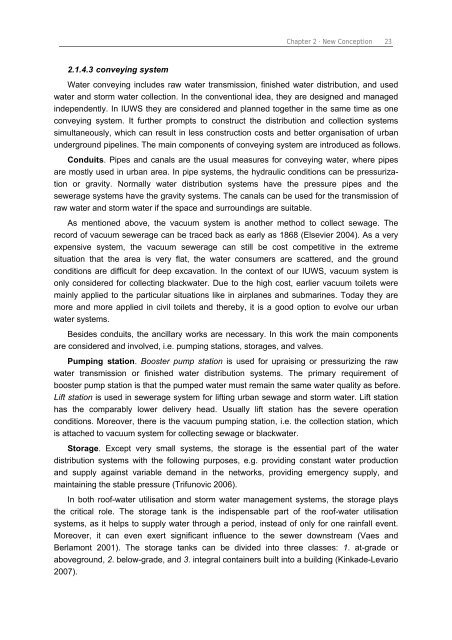Chapter 3 Decision Support Model (IUWS-DSM) - Tubdok
Chapter 3 Decision Support Model (IUWS-DSM) - Tubdok
Chapter 3 Decision Support Model (IUWS-DSM) - Tubdok
You also want an ePaper? Increase the reach of your titles
YUMPU automatically turns print PDFs into web optimized ePapers that Google loves.
2.1.4.3 conveying system<br />
<strong>Chapter</strong> 2 · New Conception 23<br />
Water conveying includes raw water transmission, finished water distribution, and used<br />
water and storm water collection. In the conventional idea, they are designed and managed<br />
independently. In <strong>IUWS</strong> they are considered and planned together in the same time as one<br />
conveying system. It further prompts to construct the distribution and collection systems<br />
simultaneously, which can result in less construction costs and better organisation of urban<br />
underground pipelines. The main components of conveying system are introduced as follows.<br />
Conduits. Pipes and canals are the usual measures for conveying water, where pipes<br />
are mostly used in urban area. In pipe systems, the hydraulic conditions can be pressurization<br />
or gravity. Normally water distribution systems have the pressure pipes and the<br />
sewerage systems have the gravity systems. The canals can be used for the transmission of<br />
raw water and storm water if the space and surroundings are suitable.<br />
As mentioned above, the vacuum system is another method to collect sewage. The<br />
record of vacuum sewerage can be traced back as early as 1868 (Elsevier 2004). As a very<br />
expensive system, the vacuum sewerage can still be cost competitive in the extreme<br />
situation that the area is very flat, the water consumers are scattered, and the ground<br />
conditions are difficult for deep excavation. In the context of our <strong>IUWS</strong>, vacuum system is<br />
only considered for collecting blackwater. Due to the high cost, earlier vacuum toilets were<br />
mainly applied to the particular situations like in airplanes and submarines. Today they are<br />
more and more applied in civil toilets and thereby, it is a good option to evolve our urban<br />
water systems.<br />
Besides conduits, the ancillary works are necessary. In this work the main components<br />
are considered and involved, i.e. pumping stations, storages, and valves.<br />
Pumping station. Booster pump station is used for upraising or pressurizing the raw<br />
water transmission or finished water distribution systems. The primary requirement of<br />
booster pump station is that the pumped water must remain the same water quality as before.<br />
Lift station is used in sewerage system for lifting urban sewage and storm water. Lift station<br />
has the comparably lower delivery head. Usually lift station has the severe operation<br />
conditions. Moreover, there is the vacuum pumping station, i.e. the collection station, which<br />
is attached to vacuum system for collecting sewage or blackwater.<br />
Storage. Except very small systems, the storage is the essential part of the water<br />
distribution systems with the following purposes, e.g. providing constant water production<br />
and supply against variable demand in the networks, providing emergency supply, and<br />
maintaining the stable pressure (Trifunovic 2006).<br />
In both roof-water utilisation and storm water management systems, the storage plays<br />
the critical role. The storage tank is the indispensable part of the roof-water utilisation<br />
systems, as it helps to supply water through a period, instead of only for one rainfall event.<br />
Moreover, it can even exert significant influence to the sewer downstream (Vaes and<br />
Berlamont 2001). The storage tanks can be divided into three classes: 1. at-grade or<br />
aboveground, 2. below-grade, and 3. integral containers built into a building (Kinkade-Levario<br />
2007).

















